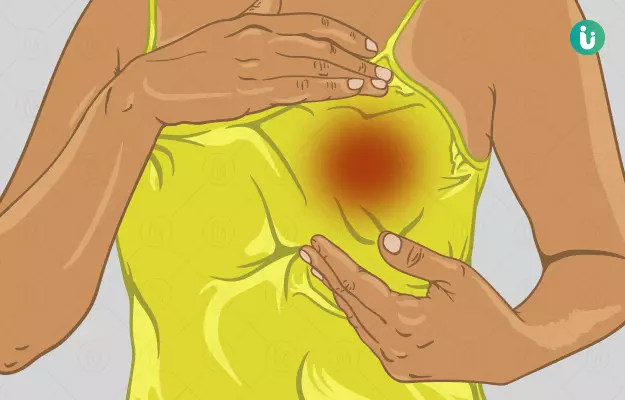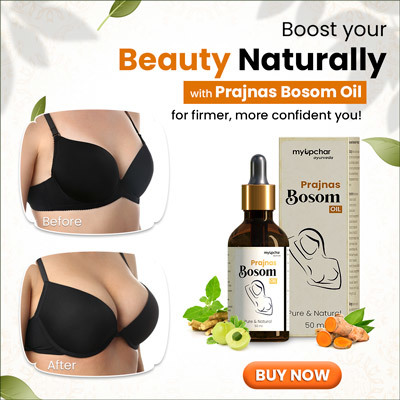A variety of factors may lead to breast pain. Most commonly it happens a few days before the start of the menstrual cycle or due to hormonal imbalance. However, there could be other reasons as well. Some of them are explained below.
Hormone imbalance
- The three major phases when hormonal fluctuation occurs is menarche (when a girl gets her period for the first time), pregnancy, and menopause (cessation of menstrual cycles). During these phases, you may experience changes in your breasts which may cause pain, heaviness, and lumpiness in breasts.
- The main cause of cyclic breast pain is your menstrual cycle. However, many studies have conflicting results. In some studies women with cyclic breast pain were found to have changes in the levels of estrogen, progesterone, and prolactin hormone in their body. The pain occurs during the luteal phase of the cycle which starts after ovulation (release of an egg from the ovaries).
- A systematic review of medical literature on causes of breast pain suggested that women who undergo hormone replacement therapy after menopause are at a higher risk of developing breast cancer. Hence, they can also experience a significant increase in breast pain.
Breast cysts
Presence of abnormal fluid-filled sacs in the breasts may also cause pain, discomfort, and heaviness in your breast. You should consult your doctor if you suspect cysts in your breasts and get yourself treated.
Breastfeeding
A study conducted on breastfeeding women with chest pain suggested that the most common cause of breast pain in them was blockage of milk ducts. Researchers found that this blockage had resulted in breast pain.
Hence, if left untreated, it may cause swelling and infection in the affected breast.
Pain in chest muscle
Sometimes, breast pain may also be felt when there is an injury, inflammation or infection of the underlying chest wall muscle. The pain can radiate from the chest muscle to your breast. Visit your doctor to get complete treatment.
Trauma
Any sudden blow or injury to your breast may cause constant breast pain. The affected area acts as a trigger point that causes pain on touching or applying pressure.
Fibrocystic disease
A lot of women have fibrocystic disease, in which breast tissues develop small fluid-filled cysts that cause lumpiness and pain in the breasts. This condition is non-cancerous and is very common. In fact, many doctors have stopped using the term "fibrocystic disease", and prefer calling it "fibrocystic breasts" instead.
Read more: Benign fibrocystic breasts symptoms
Other causes of breast pain: Here are some other causes of breast pain:
- Lateral chest wall pain
Breast pain may be experienced when there is swelling, injury or infection of the muscles on the sides of your chest just below your armpits. This pain may radiate to the breasts also.
- Costochondritis
Inflammation of the cartilage of ribs due to increased pressure is known as costochondritis. This pain originates in the chest but may also be felt in the breasts.
- Lifestyle factors
A study conducted in 2016 found that lifestyle factors like stress, anxiety, and coffee consumption are some of the factors that may lead to breast pain.
- Ill-fitting bra
A large number of women wear an ill-fitting bra, which may also be associated with pain in breasts. Make sure you wear a comfortable bra with the right measurements. To get the right measurement, use a measuring tape: You can also take help from a friend or a professional to do the measurement.
- Band size: Measure the underbust by placing the measuring under your bust.
- Bust / Cup size (A, B, C or D): Measure the bust at its fullest part, which is usually at the nipple level.
- Smoking and alcohol consumption
Substance abuse such as tobacco, alcohol, drugs, etc may also cause breast pain. They cause imbalances in the sex hormone levels in your body put you at a higher risk of developing breast problems including breast cancer.
- Cancer
Rarely, breast pain may be associated with breast cancer. According to the UK's NHS, breast pain usually isn't a symptom of breast cancer. The other causes mentioned above are much more likely to be the real reason behind pain in breasts. However, if you notice a lump in your breast along with pain, you should get it checked by a doctor immediately.
- Other medical conditions
Some other conditions in which pain may radiate to your breasts include angina (heart-related chest pain), rib fracture, coronary artery disease, anaemia, stomach ulcers, among others.
When to see a doctor?
If your breast pain is associated with other symptoms mentioned below, it is important that you consult your doctor immediately:
- Suspecting a breast lump or a lump in your armpit during self-examination.
- Nipple discharge, which is watery, whitish-yellowish or bloody.
- Dimpling (a visible depression) in your breast.
- Change in the colour of your breast.
- A deviation in the positions of your nipples.
- An ulcer on your breast skin.
- Sudden enlargement of one or both of your breasts.
Read more: Gynecomastia treatment











































